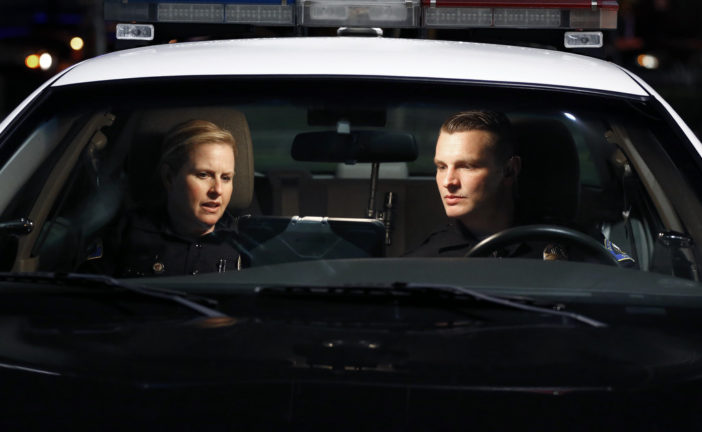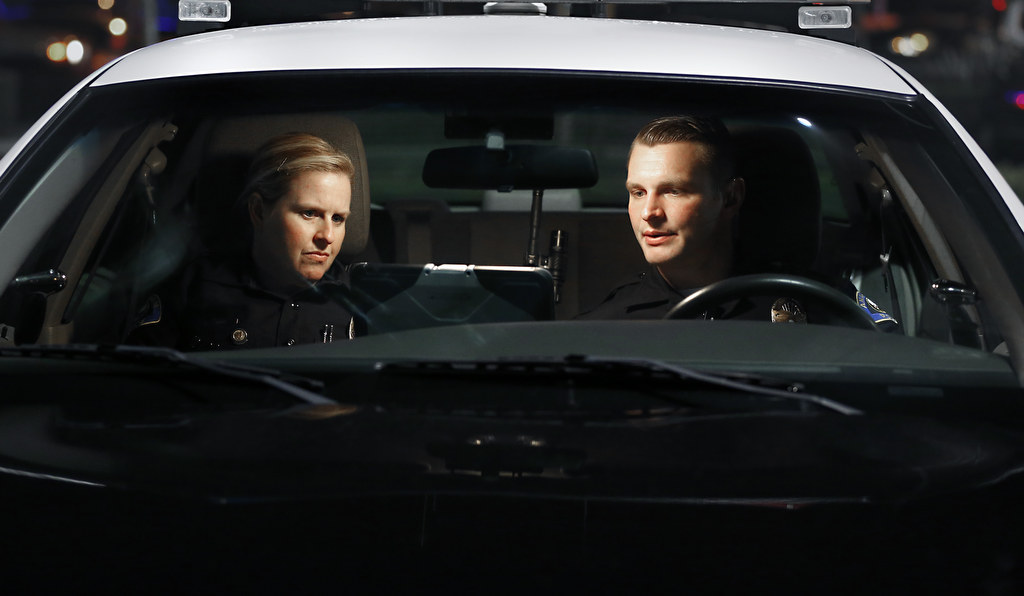The two Anaheim PD officers rolled up to the scene as a backup unit on a call about a trespasser.
The younger cop behind the wheel and his female companion, Officer Kacey Costa, got out of their patrol car.
As another officer, the first on the scene, talked to the person who called the cops, Officer Anthony McGlade, 27, approached the suspect.
McGlade saw a cutting instrument in his pocket and immediately searched him.
Costa quietly watched, taking mental notes.
Later, she would write down in a report:
(McGlade’s) observation was good but I reminded him to either alert his partner or wait until his partner is closer when he conducts a search.
Although she was riding with McGlade that night, Costa technically wasn’t his partner (the officer in the other car was).
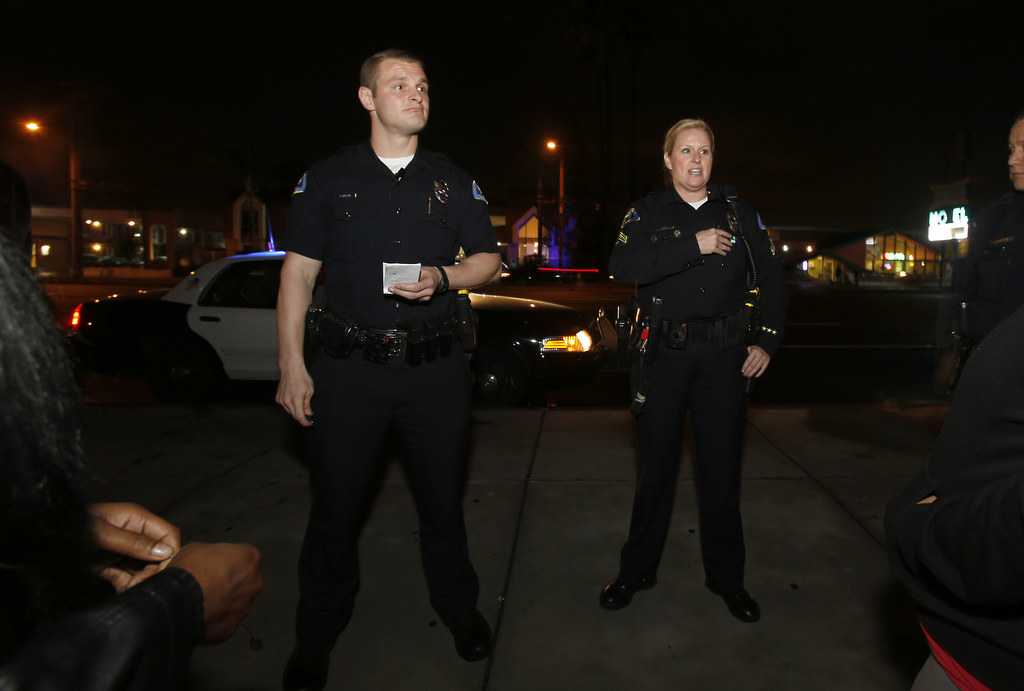
Anaheim Police Department Field Training Officer Kacey Costa and trainee Anthony McGlade make a stop along Beach Blvd. during a recent graveyard shift.
Photo by Christine Cotter/Behind the Badge OC
Instead, Costa was McGlade’s FTO, for field training officer — a critical position within the APD that typically gets little attention.
Although programs vary by agency, any time a PD hires a new cop — whether fresh from the academy or as a “lateral,” or officer from another agency — the new officer serves as a trainee for several months.
For the Anaheim PD, that means a six-phase, 5½-month process before a new hire can be sent out on his or her own — or, in rare cases, be let go or offered a non-sworn position in the department.
On a graveyard shift ride-along a few days before Christmas, Costa provided a glimpse into her role as an FTO.
She observed McGlade as he stopped to question a trio of prostitutes on Beach Boulevard and, on another call, helped him search a shuttered school whose ATM had lost its signal (the alarm company had called to make sure no one had tampered with the ATM.)
Costa said she loves being an FTO.
“I like to meet new people and I like to teach people — I find it rewarding,” said Costa, a 2o-year APD veteran who has been a full-time FTO for two years. “I love my job, and this feels like sharing.”
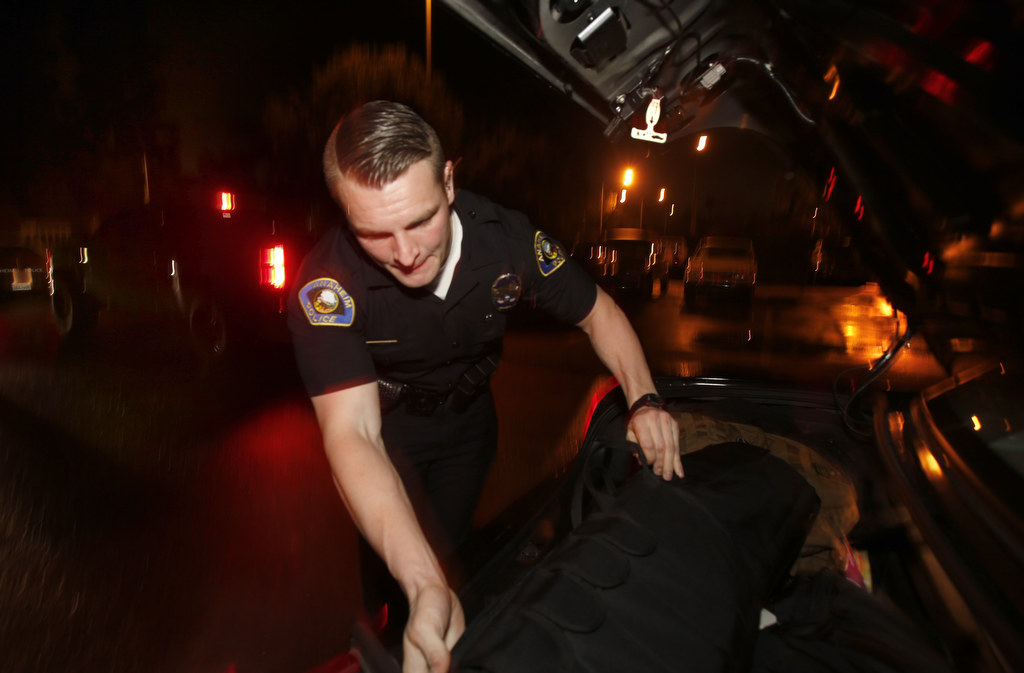
Anaheim Police Department trainee Anthony McGlade gets ready for his shift with Field Training Officer Kacey Costa.
Photo by Christine Cotter/Behind the Badge OC
***
McGlade is a cop with six years of experience who transferred from the Pasadena PD to Anaheim in October.
“It’s great,” McGlade said of being an APD trainee. “They treat me very well. Every department has its own culture. It’s an adjustment.”
Riding in a patrol car with the same person for 12 ½ hours for three days a week has its challenges.
“You’re jumping in a car with a stranger basically and trying to tell him or her how to do their job, so that can be tough,” Costa said.
As expected, the trainer and trainee learn a lot about each other.
“I know it’s a student/pupil type environment where she’s teaching, but we get to know each other personally as well,” McGlade said.
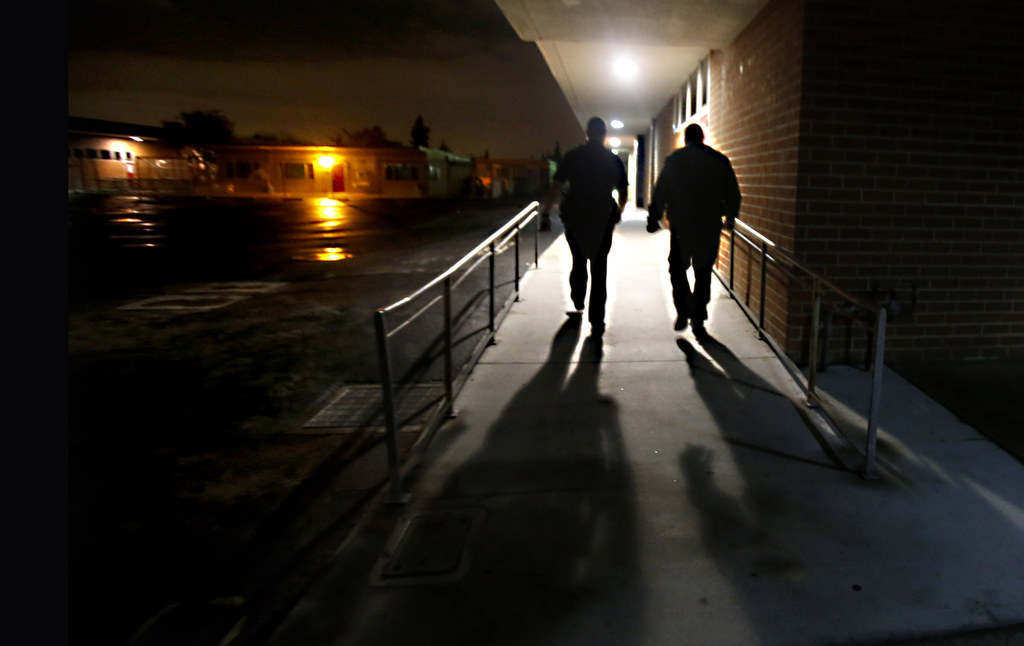
APD officers respond to a possible ATM tampering at Loara High School on Dec 22, 2015.
Photo by Christine Cotter/Behind the Badge OC
Costa pointed out the dual air in the patrol car.
“He likes his side cold,” Costa said, “and I like my warm side. So we’re OK.”
Costa added:
“I found out last night he doesn’t like tomatoes. And I learned that during the holidays, his family has ugly Christmas sweater parties.”
***
These days, the Anaheim PD’s FTO program is humming on all cylinders.
With a couple dozen officers recently having retired and the agency staffing up after years of budget cutbacks, the APD now has 28 full-time FTOs.
And because the Anaheim PD is a destination agency for new and veteran cops, the FTOs always are busy, officials say.
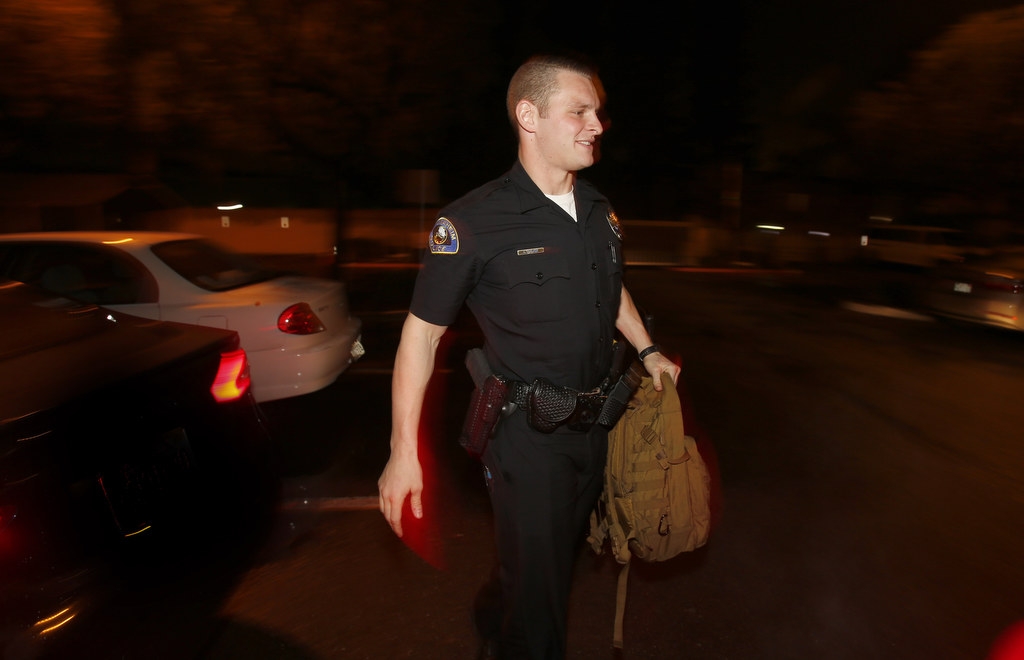
Anaheim Police Department trainee Anthony McGlade was a cop in Pasadena for six years before transferring to the Anaheim PD in October.
Photo by Christine Cotter/Behind the Badge OC
Contrary to what a casual observer might assume, the job of an FTO is not to set up a new hire for failure by nitpicking his or her every move and decision.
The APD refers to its approach to training new hires as “phase-in” as opposed to “phase-out,” said Sgt. John Olea, who runs the FTO program along with three other sergeants: Mike Fernandez, Ben Starke and Ryan Blackburn.
“What this means is we do our very best to phase our trainees into our department,” Olea said. “We do our best to provide support and the proper training to our trainees.
“If a trainee is struggling, we do what we can to help them get through. This is accomplished by such things as providing extra training and sending them to classes.
“Our hope is to get them up to speed.”
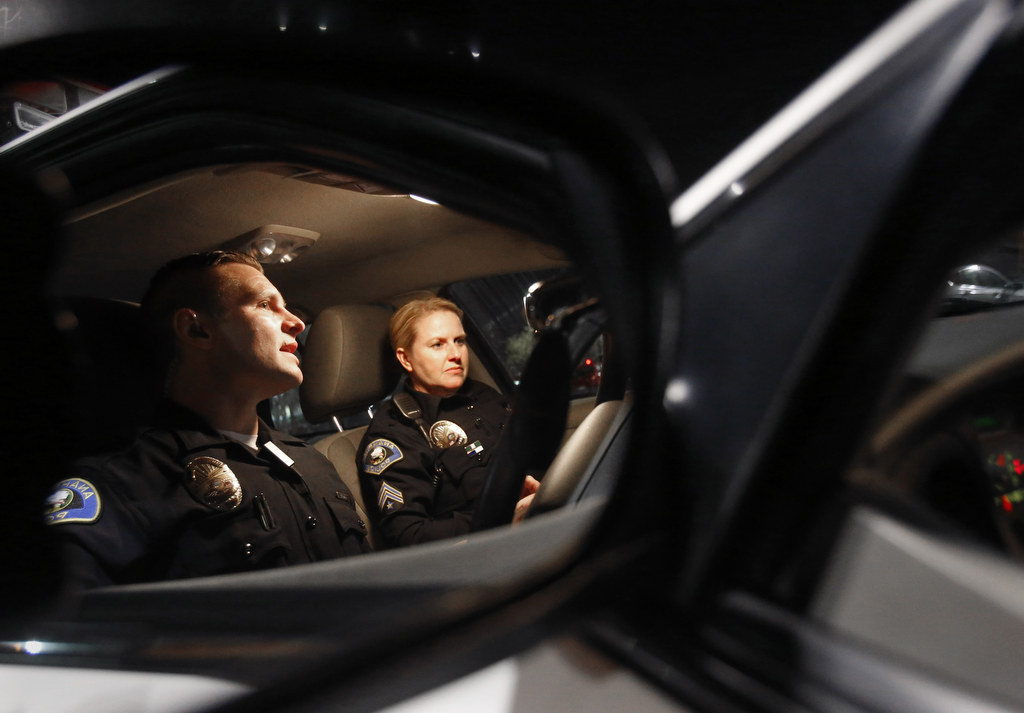
Anaheim Police Department Field Training Officer Kacey Costa goes over a report with trainee Anthony McGlade during a recent graveyard shift.
Photo by Christine Cotter/Behind the Badge OC
***
As an APD trainee progresses through each of the six phases, he or she is given more responsibilities and evaluated on his or her actions.
Phase 1 is the observation phase, during which the trainee sits in the passenger seat and just observes the FTO responding to calls and initiating contacts.
During Phase 2, the trainee drives the patrol car.
In Phase 3, the FTO dumps more responsibilities and paperwork on the trainee, and in Phase 4 the trainee is on his or her own even more.
Phase 5 is called the “ram and jam” phase, during which the trainee must master the art of contacting members of the public, making car stops and engaging in proactive policing.
Finally, Phase 6 is dubbed the “ghost phase,” where for two weeks the FTO sits and says nothing – just observes. The trainee isn’t allowed to ask the FTO questions, but instead must ask his or her partners or sergeant.
Together, all phases aim to accomplish one thing: teach the new hire about what Costa called “the Anaheim way” — learning the department’s culture and policies and the way officers do reports.
“For example,” Costa said, “one of our policies is to wait for the backup officer, who drives in another unit, on almost all calls.”
During the search of the high school where the ATM lost its signal, McGlade displayed his savvy tactical skills when he, Costa and McGlade’ partner that night — Officer Sean Guarino — came across an unlocked door that they initially believed led to the ATM.

Anaheim Police Department Field Training Officer Kacey Costa works with trainee Anthony McGlade during a recent graveyard shift.
Photo by Christine Cotter/Behind the Badge OC
“Anaheim Police Department!” McGlade barked as he prepared to enter the office. “Anyone inside the building, make yourself known now.”
McGlade and his fellow officers cleared the room, which did not house the ATM. The officers determined that someone had left the door unlocked by mistake, and after a thorough search of the high school they left with nothing suspicious to report; they figured that a technical issue caused the lost ATM signal.
Then it was off to Beach Boulevard, where McGlade led the questioning of three streetwalkers in their 20s who were dressed for summer on a cold winter’s night.
McGlade conducted the field interviews while Costa checked on the computer in their patrol car to see if the women had any warrants or were on probation or parole.
All three came up clean, although one of the women was in the system for having been previously questioned by the APD for engaging in prostitution. Although the three women admitted to being prostitutes to McGlade and Costa, they were not arrested.
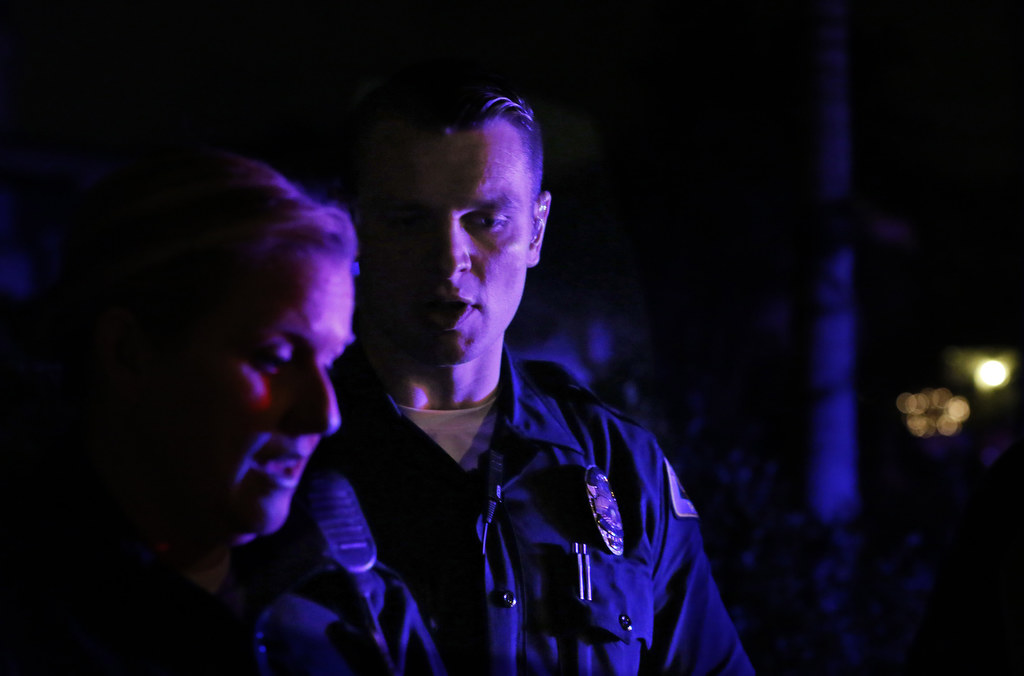
Anaheim Police Department Field Training Officer Kacey Costa goes over a report with trainee Anthony McGlade during a recent graveyard shift.
Photo by Christine Cotter/Behind the Badge OC
“It’s kind of a slippery slope,” McGlade explained. “We didn’t catch them in the act of negotiating money for sex; we can’t arrest someone for a crime they are about to commit or may be about to commit.”
McGlade and Costa instead gave the women a formal warning to leave and never to conduct their business in Anaheim again. The officers told them if they saw them walking the streets again they would be arrested.
***
McGlade is a slam dunk for making the cut as a new Anaheim PD hire.
“Our personnel department does a great job in weeding out folks who will probably not make it — therefore, we don’t hire them to begin with,” Olea said. “I’m proud to say Anaheim has a great reputation among the county and state of only hiring the highest- quality individuals.
“Make no mistake, our program isn’t easy, but it’s only a few folks here and there that do not make the program.”
Costa was asked how McGlade, who grew up in the Lake Forest area and became inspired to become a cop after a ridealong when he was 18, was doing.
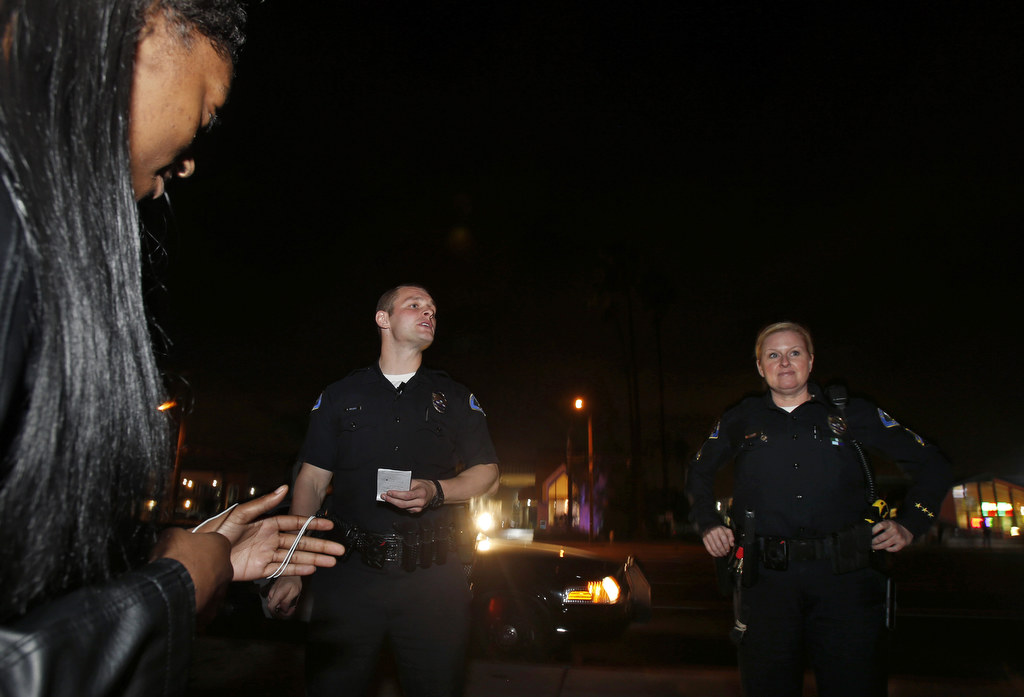
Anaheim Police Department Field Training Officer Kacey Costa and trainee Anthony McGlade make a stop along Beach Boulevard to contact three prostitutes.
Photo by Christine Cotter/Behind the Badge OC
“Are you kidding?” she said. “He’s doing great. He’s a gem.”
At the end of every shift, Costa has to fill out a Daily Observation Report that includes ranking McGlade in 16 categories, from 1 to 5 (5 being best) in such areas as conflict resolution, procedures and policies, report writing, investigative abilities, problem solving and ethics.
A rating of 3 means the trainee is doing what he or she is supposed to be doing.
Ratings of 4 and 5 are rare, but McGlade has gotten a 4 a couple of times, Costa said.
“Our culture is we want you to succeed,” Costa said. “We are not trying to fail you or browbeat you; we want you to be welcomed here and we want you to learn.”
She recalled one trainee who had trouble mastering the art of making car stops at night — where to park so the patrol car is not too close or too far from the person who was pulled over, running plates, turning on the proper lights, etc.
Costa had the trainee practice on empty cars parked in a lot in the middle of night.
“If someone is struggling with an issue,” she said, “we work on it.”
 Behind the Badge
Behind the Badge
